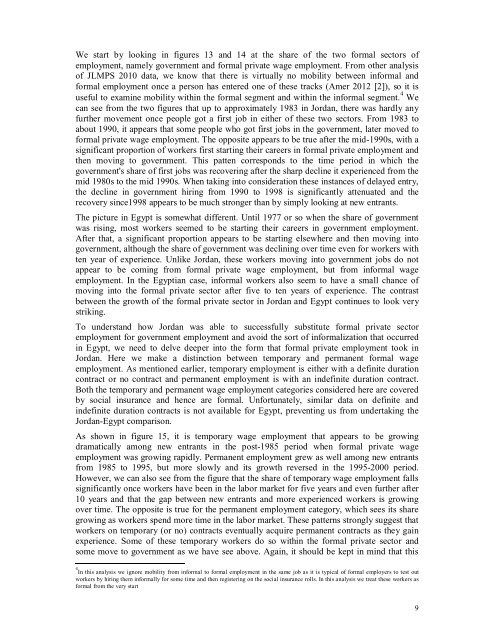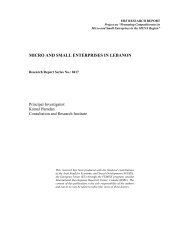The Structure and Evolution of Employment in Jordan - University of ...
The Structure and Evolution of Employment in Jordan - University of ...
The Structure and Evolution of Employment in Jordan - University of ...
You also want an ePaper? Increase the reach of your titles
YUMPU automatically turns print PDFs into web optimized ePapers that Google loves.
We start by look<strong>in</strong>g <strong>in</strong> figures 13 <strong>and</strong> 14 at the share <strong>of</strong> the two formal sectors <strong>of</strong>employment, namely government <strong>and</strong> formal private wage employment. From other analysis<strong>of</strong> JLMPS 2010 data, we know that there is virtually no mobility between <strong>in</strong>formal <strong>and</strong>formal employment once a person has entered one <strong>of</strong> these tracks (Amer 2012 [2]), so it isuseful to exam<strong>in</strong>e mobility with<strong>in</strong> the formal segment <strong>and</strong> with<strong>in</strong> the <strong>in</strong>formal segment. 4 Wecan see from the two figures that up to approximately 1983 <strong>in</strong> <strong>Jordan</strong>, there was hardly anyfurther movement once people got a first job <strong>in</strong> either <strong>of</strong> these two sectors. From 1983 toabout 1990, it appears that some people who got first jobs <strong>in</strong> the government, later moved t<strong>of</strong>ormal private wage employment. <strong>The</strong> opposite appears to be true after the mid-1990s, with asignificant proportion <strong>of</strong> workers first start<strong>in</strong>g their careers <strong>in</strong> formal private employment <strong>and</strong>then mov<strong>in</strong>g to government. This patten corresponds to the time period <strong>in</strong> which thegovernment's share <strong>of</strong> first jobs was recover<strong>in</strong>g after the sharp decl<strong>in</strong>e it experienced from themid 1980s to the mid 1990s. When tak<strong>in</strong>g <strong>in</strong>to consideration these <strong>in</strong>stances <strong>of</strong> delayed entry,the decl<strong>in</strong>e <strong>in</strong> government hir<strong>in</strong>g from 1990 to 1998 is significantly attenuated <strong>and</strong> therecovery s<strong>in</strong>ce1998 appears to be much stronger than by simply look<strong>in</strong>g at new entrants.<strong>The</strong> picture <strong>in</strong> Egypt is somewhat different. Until 1977 or so when the share <strong>of</strong> governmentwas ris<strong>in</strong>g, most workers seemed to be start<strong>in</strong>g their careers <strong>in</strong> government employment.After that, a significant proportion appears to be start<strong>in</strong>g elsewhere <strong>and</strong> then mov<strong>in</strong>g <strong>in</strong>togovernment, although the share <strong>of</strong> government was decl<strong>in</strong><strong>in</strong>g over time even for workers withten year <strong>of</strong> experience. Unlike <strong>Jordan</strong>, these workers mov<strong>in</strong>g <strong>in</strong>to government jobs do notappear to be com<strong>in</strong>g from formal private wage employment, but from <strong>in</strong>formal wageemployment. In the Egyptian case, <strong>in</strong>formal workers also seem to have a small chance <strong>of</strong>mov<strong>in</strong>g <strong>in</strong>to the formal private sector after five to ten years <strong>of</strong> experience. <strong>The</strong> contrastbetween the growth <strong>of</strong> the formal private sector <strong>in</strong> <strong>Jordan</strong> <strong>and</strong> Egypt cont<strong>in</strong>ues to look verystrik<strong>in</strong>g.To underst<strong>and</strong> how <strong>Jordan</strong> was able to successfully substitute formal private sectoremployment for government employment <strong>and</strong> avoid the sort <strong>of</strong> <strong>in</strong>formalization that occurred<strong>in</strong> Egypt, we need to delve deeper <strong>in</strong>to the form that formal private employment took <strong>in</strong><strong>Jordan</strong>. Here we make a dist<strong>in</strong>ction between temporary <strong>and</strong> permanent formal wageemployment. As mentioned earlier, temporary employment is either with a def<strong>in</strong>ite durationcontract or no contract <strong>and</strong> permanent employment is with an <strong>in</strong>def<strong>in</strong>ite duration contract.Both the temporary <strong>and</strong> permanent wage employment categories considered here are coveredby social <strong>in</strong>surance <strong>and</strong> hence are formal. Unfortunately, similar data on def<strong>in</strong>ite <strong>and</strong><strong>in</strong>def<strong>in</strong>ite duration contracts is not available for Egypt, prevent<strong>in</strong>g us from undertak<strong>in</strong>g the<strong>Jordan</strong>-Egypt comparison.As shown <strong>in</strong> figure 15, it is temporary wage employment that appears to be grow<strong>in</strong>gdramatically among new entrants <strong>in</strong> the post-1985 period when formal private wageemployment was grow<strong>in</strong>g rapidly. Permanent employment grew as well among new entrantsfrom 1985 to 1995, but more slowly <strong>and</strong> its growth reversed <strong>in</strong> the 1995-2000 period.However, we can also see from the figure that the share <strong>of</strong> temporary wage employment fallssignificantly once workers have been <strong>in</strong> the labor market for five years <strong>and</strong> even further after10 years <strong>and</strong> that the gap between new entrants <strong>and</strong> more experienced workers is grow<strong>in</strong>gover time. <strong>The</strong> opposite is true for the permanent employment category, which sees its sharegrow<strong>in</strong>g as workers spend more time <strong>in</strong> the labor market. <strong>The</strong>se patterns strongly suggest thatworkers on temporary (or no) contracts eventually acquire permanent contracts as they ga<strong>in</strong>experience. Some <strong>of</strong> these temporary workers do so with<strong>in</strong> the formal private sector <strong>and</strong>some move to government as we have see above. Aga<strong>in</strong>, it should be kept <strong>in</strong> m<strong>in</strong>d that this4 In this analysis we ignore mobility from <strong>in</strong>formal to formal employment <strong>in</strong> the same job as it is typical <strong>of</strong> formal employers to test outworkers by hir<strong>in</strong>g them <strong>in</strong>formally for some time <strong>and</strong> then register<strong>in</strong>g on the social <strong>in</strong>surance rolls. In this analysis we treat these workers asformal from the very start9

















